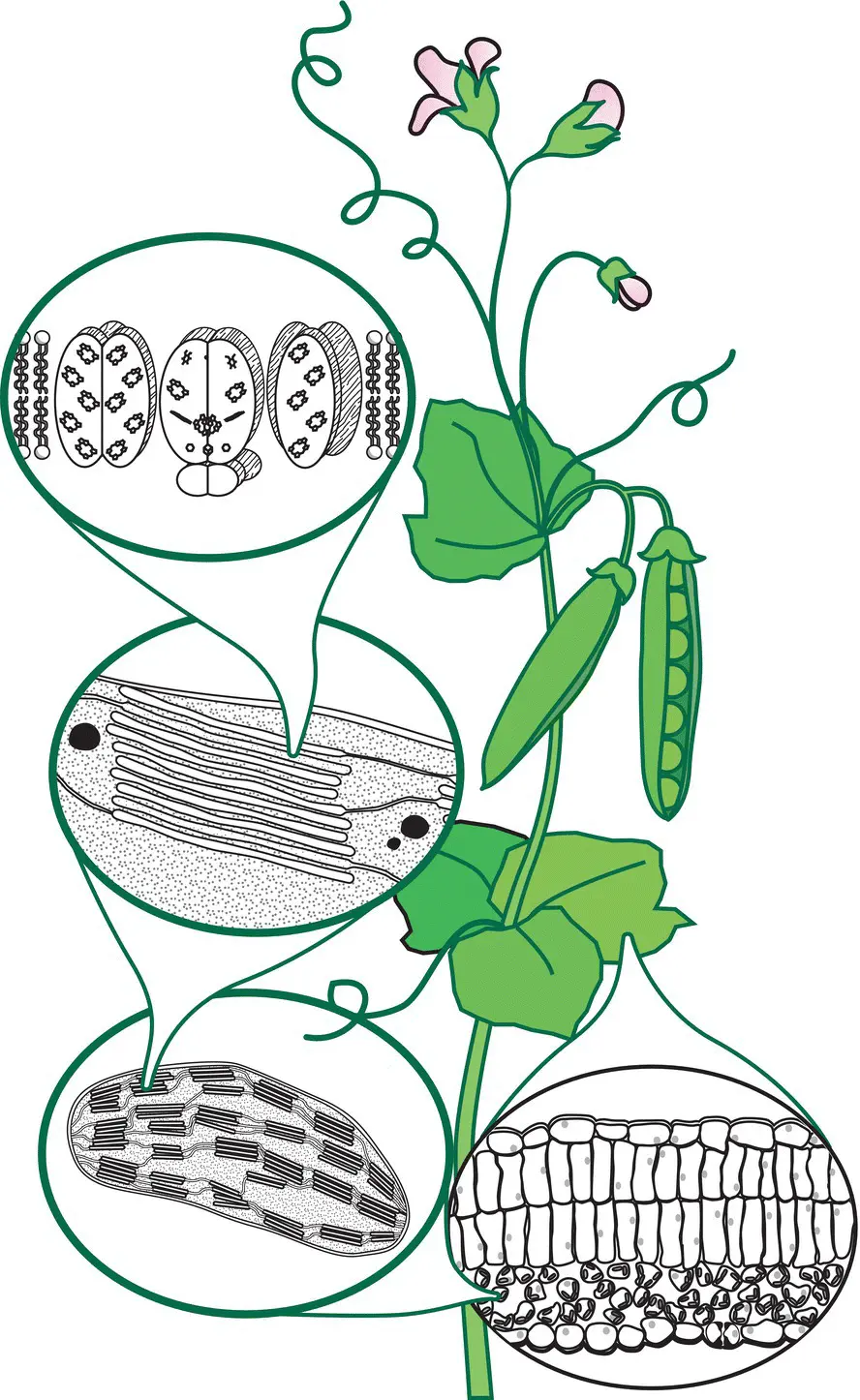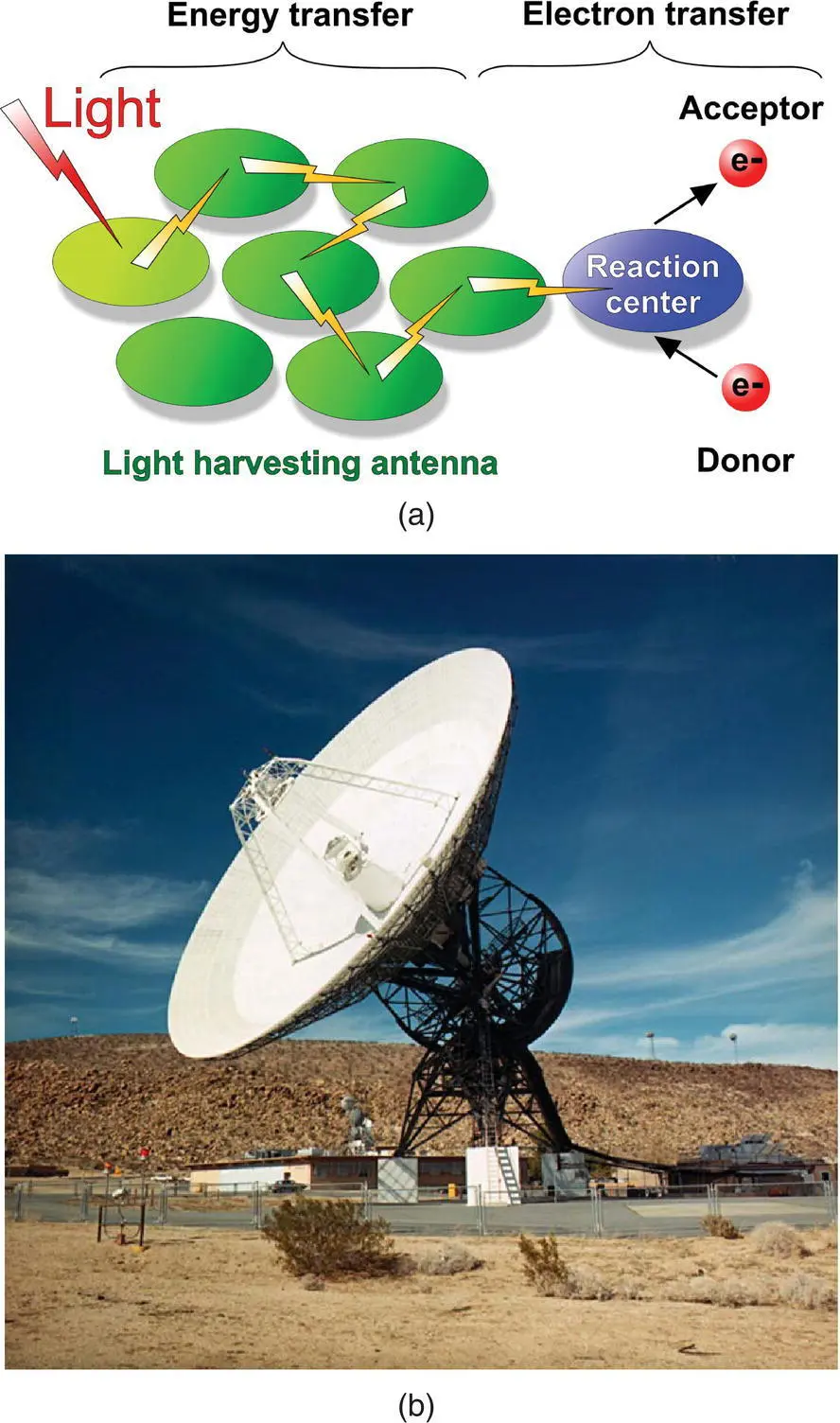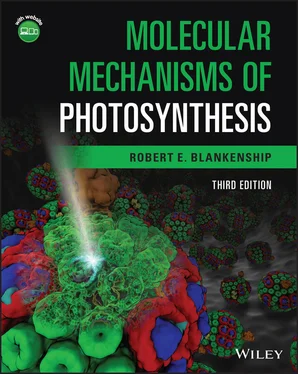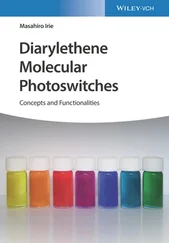
Figure 1.2 Exploding diagram of the photosynthetic apparatus of a typical higher plant. The first expansion bubble shows a cross‐section of a leaf, with the different types of cells; the dark spots are the chloroplasts. The second bubble is a chloroplast; the thylakoid membranes are the dark lines; the stroma is the stippled area. The third bubble shows a grana stack of thylakoids. The fourth bubble shows a schematic picture of the molecular structure of the thylakoid membrane, with a reaction center flanked by antenna complexes.
Source: Courtesy of Aileen Taguchi.
An extensive membrane system is found within the chloroplast, and all the chlorophylls and other pigments are found associated with these membranes, which are known as thylakoids, or sometimes called lamellae. In typical higher plant chloroplasts, most of the thylakoids are closely associated in stacks and are known as grana thylakoid membranes, while those that are not stacked are known as stroma thylakoid membranes. The thylakoid membranes are the sites of light absorption and the early or primary reactions that first transform light energy into chemical energy. The nonmembranous aqueous interior of the chloroplast is known as the stroma. The stroma contains soluble enzymes and is the site of the carbon metabolism reactions that ultimately give rise to products that can be exported from the chloroplast and used elsewhere in the plant to support other cellular processes.
In prokaryotic photosynthetic organisms, the early steps of photosynthesis take place on specialized membranes that are derived from the cell's cytoplasmic membrane. In these organisms, the carbon metabolism reactions take place in the cell cytoplasm, along with all the other reactions that make up the cell's metabolism.
1.4 The four phases of energy storage in photosynthesis
It is convenient to divide photosynthesis into four distinct phases, which together make up the complete process, beginning with photon absorption and ending with the export of stable carbon products from the chloroplast. The four phases are as follows: (1) light absorption and energy delivery by antenna systems, (2) primary electron transfer in reaction centers, (3) energy stabilization by secondary processes, and (4) synthesis and export of stable products.
The terms light reactionsand dark reactionshave traditionally been used to describe different phases of photosynthetic energy storage. The first three phases that we have identified make up the light reactions, and the fourth encompasses the dark reactions. However, this nomenclature is somewhat misleading, in that all the reactions are ultimately driven by light, yet the only strictly light‐dependent step is photon absorption. In addition, several enzymes involved in carbon metabolism are regulated by compounds produced by light‐driven processes. We will now briefly explore each of the phases of photosynthetic energy storage, with the emphasis on the basic principles. Much more detail is given in the later chapters dedicated to each topic.
1.4.1 Antennas and energy transfer processes
For light energy to be stored by photosynthesis, it must first be absorbed by one of the pigments associated with the photosynthetic apparatus. Photon absorption creates an excited state that eventually leads to charge separation in the reaction center. Not every pigment carries out photochemistry; the vast majority function as antennas, collecting light and then delivering energy to the reaction center where the photochemistry takes place. The antenna system is conceptually similar to a satellite dish, collecting energy and concentrating it in a receiver, where the signal is converted into a different form ( Fig. 1.3). Energy transfer in antenna systems is discussed in more detail in Chapter 5.
The antenna system does not do any chemistry; it works by an energy transfer process that involves the migration of electronic excited states from one molecule to another. This is a purely physical process, which depends on a weak energetic coupling of the antenna pigments. In almost all cases, the pigments are bound to proteins in highly specific associations. In addition to chlorophylls, common antenna pigments include carotenoids and open‐chain tetrapyrrole bilin pigments found in phycobilisome antenna complexes.

Figure 1.3 (a) Schematic diagram illustrating the concept of antennas in photosynthetic organisms. Light is absorbed by a pigment, which can be either a type of chlorophyll or an accessory pigment. Energy transfer takes place in which the excited state migrates throughout the antenna system and is eventually delivered to the reaction center where electron transfer takes place, creating an oxidized electron donor and a reduced electron acceptor. (b) Radio telescope as an analogy to the photosynthetic antenna. The dish serves as the antenna, collecting energy and delivering it to the receiver, which transduces it into a signal.
Source: NASA.
Antenna systems often incorporate an energetic and spatial funneling mechanism, in which pigments that are on the periphery of the complex absorb at shorter wavelengths and therefore higher excitation energies than those at the core. As energy transfer takes place, the excitation energy moves from higher‐ to lower‐energy pigments, at the same time heading toward the reaction center.
Antenna systems greatly increase the amount of energy that can be absorbed compared with a single pigment. Under most conditions, this is an advantage, because sunlight is a relatively dilute energy source. Under some conditions, however, especially if the organism is subject to some other form of stress, more light energy can be absorbed than can be used productively by the system. If unchecked, this can lead to severe damage in short order. Even under normal conditions, the system is rapidly inactivated if some sort of photoprotection mechanism is not present. Antenna systems (as well as reaction centers) therefore have extensive and multifunctional regulation, protection, and repair mechanisms.
The number of antenna pigments associated with each reaction center complex varies widely, from a minimum of a few tens of pigments in some organisms to a maximum of several thousand pigments in other types of organisms. The pigment number and type largely reflect the photic environment that the organism lives in. Smaller antennas are found in organisms that live in high intensity conditions, while the large antennas are found in environments where light intensity is low.
1.4.2 Primary electron transfer in reaction centers
The transformation from the pure energy of excited states to chemical changes in molecules takes place in the photosynthetic reaction center. The reaction center is a multisubunit protein complex that is embedded in the photosynthetic membrane. It is a pigment–protein complex, incorporating chlorophyll or bacteriochlorophyll and carotenoid pigments as well as other cofactors such as quinones or iron sulfur centers, which are involved in electron transfer processes. The cofactors are bound to extremely hydrophobic polypeptides that thread back and forth across the nonpolar portion of the membrane multiple times.
The reaction center contains a special dimer of pigments that in most or all cases is the primary electron donorfor the electron transfer cascade. These pigments are chemically identical (or nearly so) to the chlorophylls that are antenna pigments, but their environment in the reaction center protein gives them unique properties. The final step in the antenna system is the transfer of energy into this dimer, creating an excited dimer that has been electronically excited to a higher energy level.
Читать дальше














